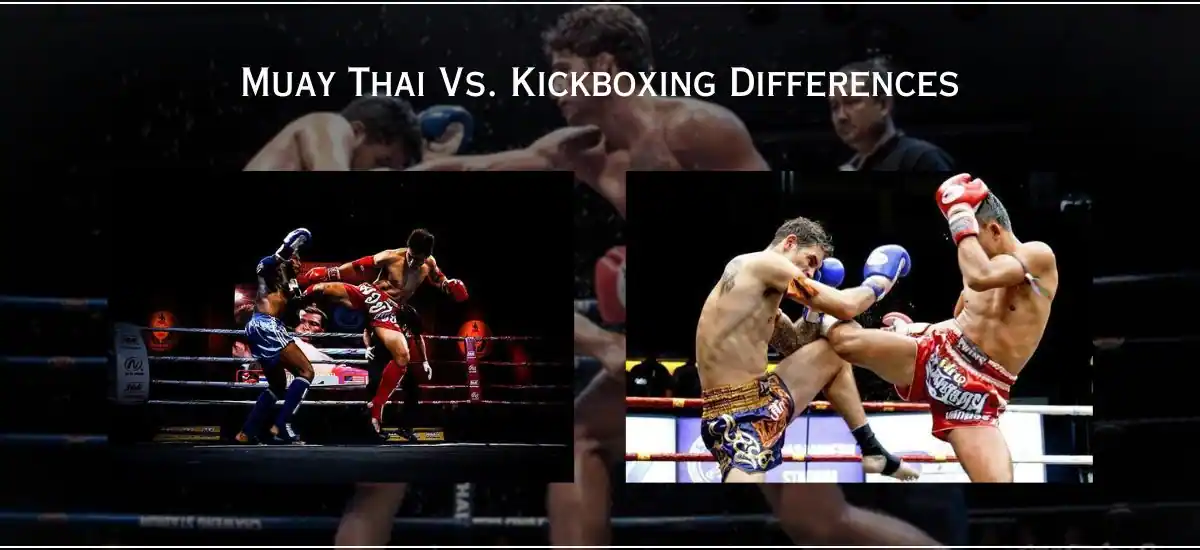Although many people confuse Muay Thai with kickboxing, they differ in many ways, including fighting styles and methods. Yes, there are common methods shared by the two sports, but how these skills are used varies depending on the fighter and the sport.
Their definitions exemplify their distinction: kickboxing refers to any sport that involves the use of kicks and hands in a full-contact environment, whereas Muay Thai, also known as Thai boxing, refers to a combat sport that originated in Thailand and employed stand-up striking as well as various clinching techniques.
Thus, as detailed in this article, Muay Thai falls within the genre of kickboxing in general terms, although there are more variances than similarities.
Similarities Of Muay Thai And Kickboxing:
Muay Thai and kickboxing are extremely strategic setups, teaching footwork and other tactics to escape and strike punches at the opponent. Similarly, many of the skills developed in Muay Thai are identical to those taught in kickboxing, particularly the foundations.
Both sports are striking martial arts that have been successful at the highest levels of competition on many occasions.
Muay Thai Vs. Kickboxing Differences
Muay Thai and kickboxing are striking martial arts that originated in Asia and have gained popularity worldwide. While they share many similarities in terms of the techniques used and the overall goal of hitting an opponent, there are also several key differences between the two martial arts:

1. Origins: Muay Thai is a martial art that originated in Thailand, while kickboxing is a mixed martial art that combines elements of karate and boxing.
2. Techniques: Muay Thai emphasizes using strikes using the shins and knees and clinching scenarios to control an opponent. Kickboxing does not typically involve the use of resolving or the shins and knees to deliver strikes.
3. Equipment: Muay Thai fighters typically wear no protective gear or gloves, while kickboxing fighters usually wear gloves and other protective gear, such as headgear and shin guards.
4. Training and competition: Muay Thai training and competition often has a more traditional martial arts feel, with fighters wearing traditional Muay Thai robes and performing a ceremonial dance called the “Wai Kru” before a match.
Kickboxing training and competition are typically more modern and sport-oriented, with fighters wearing stylish boxing gloves and protective gear.
5. Rules: Muay Thai and kickboxing have different rules and regulations governing their competitions. Muay Thai competitions may use techniques not permitted in kickboxing, such as elbow strikes and certain clinch holds.
Rules Of Kickboxing
Kickboxing is a mixed martial art that combines elements of karate and boxing. The rules of kickboxing vary depending on the specific organization or promoter hosting the event, but some general rules are commonly followed in kickboxing competitions:
1. Fighters may be disqualified if they commit a severe foul, cannot continue fighting or are deemed unable to defend themselves by the referee.
2. Matches are typically held in a boxing ring or an enclosed area with ropes or padded barriers.
3. Fighters can use punches, kicks, and knee strikes to attack their opponents but are not typically allowed to use elbows or clinching techniques.
4. Matches are usually divided into rounds, with a set time for each game and a break between games. The length of the bands and the number of rounds in a match can vary, but a typical kickboxing match consists of 3 rounds of 3 minutes each.
5. Foul techniques such as headbutting, biting, and intentionally striking an opponent in the back of the head or spine are not allowed.
6. The referee may stop a match if one fighter dominates the other and the outcome is no longer in doubt. In such cases, the fighter ahead on points or appears to be in control of the fight is typically declared the winner.
7. Fighters must wear gloves and protective groin cups and may also be required to wear other protective gear, such as headgear and shin guards.
See Also: Muay Thai Vs. Kickboxing: Differences Between Them
Rules Of Muay Thai
Muay Thai is a martial art that originated in Thailand and is known for its emphasis on strikes using the shins and knees and its clinching techniques.
1. Foul techniques such as headbutting, biting, and intentionally striking an opponent in the back of the head or spine are not allowed.
2. The rules of Muay Thai vary depending on the specific organization or promoter hosting the event, but some general rules are commonly followed in Muay Thai competitions:
3. Matches are typically held in a boxing ring or an enclosed area with ropes or padded barriers.
4. The referee may stop a match if one fighter dominates the other and the outcome is no longer in doubt. In such cases, the fighter ahead on points or appears to be in control of the fight is typically declared the winner.
5. Fighters may be disqualified if they commit a severe foul, cannot continue fighting, or are deemed unable to defend themselves by the referee.
6. Fighters must wear gloves and protective groin cups but are not typically allowed to wear other protective gear, such as headgear or shin guards.
7. Fighters are allowed to use punches, kicks, elbows, and knee strikes to attack their opponents and are also entitled to use clinching techniques to control their opponents.
8. Matches are usually divided into rounds, with a set time for each game and a break between games. The length of the bands and the number of rounds in a match can vary, but a typical Muay Thai match consists of 5 rounds of 3 minutes each.
Frequently Asked Questions
Q1. Can a Muay Thai fighter fight in kickboxing?
Ans. Yes, a Muay Thai fighter can compete in kickboxing. Many Muay Thai fighters have transitioned to kickboxing and have had successful sports careers.
Q2. What’s the difference between kickboxing and Muay Thai kickboxing?
Ans. Kickboxing is primarily a boxing-based sport with active use of hands, angles, moves, and volume combinations.
At the same time, Muay Thai is a timed sport with a significant dependence on rapid and powerful counter-attacks.
Q3. What’s better, Muay Thai or kickboxing?
Ans. Muay Thai is often regarded as the most comprehensive martial art since it involves the clinch, elbow strikes, & knee strikes, while kickboxing does not. However, training in both martial arts might provide significant benefits.
Q4. How much damage can a leg kick do?
Ans. Leg kicks can cause pain, muscle damage, and even bone fractures.
Here is a more detailed answer:
- Leg kicks can cause pain and muscle damage by bruising the muscles and tendons in the leg.
- Repeated leg kicks can also damage the bones in the leg, leading to fractures.
- In some cases, leg kicks can even damage the sciatic nerve, which can cause numbness and weakness in the leg.
Overall, leg kicks are a powerful and effective weapon that can cause significant damage to an opponent’s leg.
Check More Posts:

